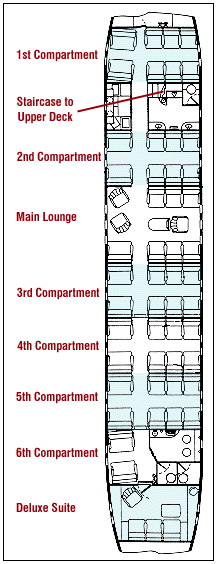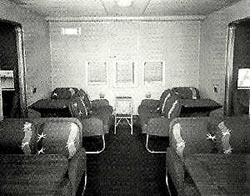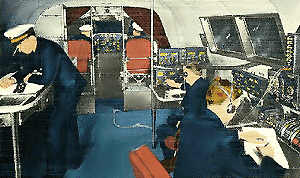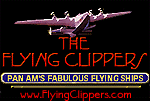
 The Boeing 314's were stately flying boats. The experience rivaled that of the ocean liners that widely used at that time. Sleeping berths, lounges, luxurious lavatories, silver goblets, hot meals on real china served by white-coated stewards, were all part of what Pan Am offered its passengers. From the outside, two irregular rows of big rectangular windows marked the upper and lower decks of the Clipper. The upper deck was made up of the flight cabin and the baggage holds. At right, is the deck plan of the lower, passenger level of the B-314. Unlike the typical rows a seats in most passenger aircraft, the passenger deck was laid out as a series of lounges with couches. As you moved to the back of the plane, there were steps up into the next compartment due to the curvature of the bottom of the plane. The couches were made into beds at night. The main lounge was transformed into the dining room at mealtimes.
A passenger could expect to have all their needs catered to by the ever attentive stewards. Food and drink were always available whenever you wanted it. Curtained bunks were made up for the passengers at night. The thick carpeting, soft lighting, comfortable upholstery in soothing colors, and the heavy soundproofing in the walls, all helped to create a special world set apart from the weather and world rushing by outside the windows. A favorite drink served on the Clippers was the Clipper Cocktail. The series of lounges were decorated in alternating color schemes — turquoise carpet with pale green walls or rust carpet with beige walls. The compartments could seat up to ten passengers each on a daytime flight, but overnight flights carried less as it could only sleep six.
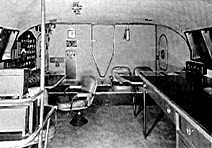 As seen in the picture above, on the port (left) side was the navigator's seven foot long chart table. Beyond that (as shown at right) was a small conference table and a oval hatch leading to the crawl way inside the wing. The engines could be reached for simple maintenance or repairs, during the flight if necessary, through this crawlway.
As seen in the picture above, on the port (left) side was the navigator's seven foot long chart table. Beyond that (as shown at right) was a small conference table and a oval hatch leading to the crawl way inside the wing. The engines could be reached for simple maintenance or repairs, during the flight if necessary, through this crawlway.
On the starboard (right) side, behind the cockpit, was the circular staircase that led down to the passenger compartment. Then came the radio operator's station. Behind him was the oval hatch that led to the starboard wing crawl way. Along the back wall of the flight deck was a doorway that led to the cargo holds. Navigation of course, was not as developed then as it is today. The navigator made use of the observation dome located between the cargo holds. He would take sightings on the stars with his sextant. By interpreting an angle reading in his book of tables, he could determine the planes position on the earth's surface. It was possible however, to be flying through cloud cover for the whole journey and never get see a star at all. In this case they had to maintain a steady course by employing a method called dead reckoning. This method worked well but had one major wrinkle. The wind could blow them sideways. To compensate for this, the drift was estimated by dropping a flare into the water through a little trapdoor in the wing. By carefully watching the flare to see if it stayed in line with the tail of the plane or moved to one side or the other, the navigator could estimate the drift.
Copyright © 1999-2021 Flying Clippers All Rights Reserved All materials contained in http://www.flyingclippers.com are protected by copyright and trademark laws and may not be used for any purpose whatsoever other than private, non-commercial viewing purposes. Derivative works and other unauthorized copying or use of stills, video footage, text or graphics is expressly prohibited. | ||||||||||||||
